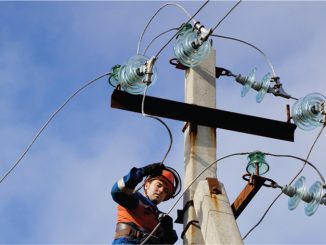
Ocean energy or marine energy includes all forms of renewable energy derived from the ocean including wave, tidal, current, salinity-gradient energy and ocean thermal energy conversion (OTEC). In August 2019, the Ministry of New and Renewable Energy (MNRE) clarified that power produced using various forms of ocean energy is to be categorised under renewables. Accordingly, ocean energy became eligible for meeting the non-solar renewable purchase obligations. The MNRE invited all entities willing to utilise ocean energy for the demonstration of projects with proven technologies under the Research, Design, Development and Demonstration programme. Later, in June 2020, the Kerala government and the MNRE planned to explore the potential of wave energy generation off the Vizhinjam coast. A 150 kW pilot project was planned near the international container terminal station. Oscilla Power was selected to provide the technology. If the technology is successful, the state government plans to set up a 1 MW wave energy plant at the same location. In October 2020, New and Renewable Energy Development Corporation of Andhra Pradesh Limited was in talks with Israel-based Eco Wave Power for the installation of an experimental 100 kW wave energy plant. Further, the state reported that Bharat Heavy Electricals Limited had proposed the development of a 1 MW wave energy plant in Visakhapatnam. The energy generated will be used for desalination and water purification in tribal areas.
In June 2021, the Ministry of Earth Sciences’ proposal on the “Deep Ocean Mission” was approved. The mission consists of six major components. Of these, one is on energy and fresh water from the ocean, envisaging studies and detailed engineering design for offshore OTEC-powered desalination plants. A key policy concern has been the high initial capital cost of the project along with high transmission costs. In January 2018, Raj Kumar Singh, union minister for power and new and renewable energy, had informed in a written reply to Parliament that tidal energy cannot be harnessed on a commercial basis due to the high capital cost ranging from Rs 300 million to Rs 600 million per MW.
Policy implications for India
In a recent paper by Sankhadeep Chakraborty, CERC; and Prasoom Dwivedi, Sushanta K. Chatterjee, Rajesh Gupta, School of Business, University of Petroleum & Energy Studies, in Energy Policy titled “Factors to Promote Ocean Energy in India”, the need to diversify India’s energy mix by adding ocean energy has been highlighted. This is crucial given that the country’s energy demand is expected to rise to 4,000 TWh by 2030. To meet the renewable energy targets by 2030, an additional 350 GW of renewable energy capacity will be needed. This is a matter of concern as the existing renewable energy sources are land intensive and highly intermittent, with a low capacity utilisation factor (CUF). Thus, they are unable to support the baseload requirement. According to the Centre for Science Technology and Policy and the Nature Conservancy, to meet the 175 GW target by 2022, a land area equivalent to Himachal Pradesh or Chhattisgarh will be needed. Similarly, to meet the 440 GW solar and wind target by 2030, land area more than the area of Rajasthan will be needed.
The paper mentions that the total theoretical ocean energy potential in India is 229-372.5 GW. It is distributed between OTEC (180-300 GW), wave (40-60 GW) and tidal (9-12.5 GW) energy. The current installed capacity of all these energy sources is zero. The paper also compares the levellised cost of energy (LCOE) of different technologies based on estimated capital costs. The capital cost of ocean, hydro, wind and solar energy per MW is Rs 212.22 million, Rs 75.46 million, Rs 40 million and Rs 30 million respectively. The total cost of these technologies per kWh, that is, LCOE plus balancing cost, is Rs 5.01, Rs 4.50, Rs 3.54 and Rs 3.46 respectively. While the balancing cost for wind and solar is Rs 1.10 per kWh, it is zero for hydro and ocean energy.
The paper highlights several benefits of ocean energy projects. Such projects offer two revenue streams – electricity generation and by-products like potable water, hydrogen, ammonia, methanol, concentrated carbon dioxide and oxygen-enriched air. In addition, the CUF of an ocean energy system is 90-92 per cent with a plant life of 30-35 years and even more than 50 years in some cases. Other benefits include no land requirement and non-intermittency. Based on a survey, the top-ranked variables for creating policy for the sector include grid connectivity, long-term policy continuity, attractive interest rate for capital, precise technical information about potential sites, generation-based incentives, and R&D support for domestic production of equipment components.
Going forward, with economies of scale and policy and regulatory support, it is possible to achieve grid parity for ocean energy technologies in the foreseeable future.



